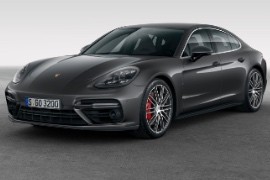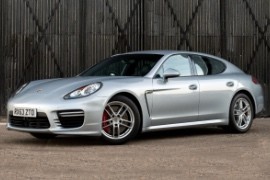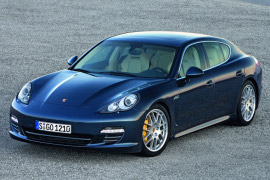PORSCHE Panamera Turbo Models/Series Timeline, Specifications & Photos
First production year: 2009
Engines: Gasoline
The four-door Porsche was already worldwide accepted even by the Porsche fans who blamed the German car-maker for the cars that saved the brand: the Cayenne and the Panamera.
The second generation of the Panamera showed up in 2016 and its design fixed all the problems of the first generation. The nice look of a four-door coupe, combined with the exterior details of the vehicle, made it up for those who waited and trusted the Porsche brand. It looked like a stretched 911 model, but with the engine in the front. The 4-LED headlights fitted as standard were one of the key design elements that made the car attractive. The Panamera 4S featured 19” light-alloy wheels and only two colors as standard: black and white as standard. Strangely, the rear windscreen wiper was fitted as an option and so was the reversing camera.
The infotainment system can be paired with either a Bose or a Burmeister premium sound system for a better audio quality offered as an option. The system can be paired with a smartphone via a Porsche dedicated app. The Android Auto was not available. The standard, 14-way adjustable seats could have been upgraded to an 18-way pair of seats.
The Panamera Turbo was the best balance between performance, luxury, and comfort. The new, 4.0-liter twin-turbo engine offered 30 hp more than its predecessor, despite having a smaller displacement. The PASM (Porsche Adaptive Suspension Management) was fitted as an option and so was the Porsche Chrono Package. It was fitted as standard with a 7-speed (PDK – dual-clutch) automatic transmission which sent its torque in all corners via PTM (Porsche Traction Management) system.
At the beginning of 2014, the Turbo version of the Panamera range was released. The main changes were the long-wheelbase version and the addition of 20 hp for the engine.
The Turbo was the flagship for most of the Porsche vehicles since the beginning of the '70s on the 911 range. It was the perfect balance between comfort and performance. The Turbo S moved the scale toward the sportive factor.
The Panamera facelift was unveiled at the Shanghai Motor Show in 2013 while the Turbo version was introduced in January 2014. It was offered as a Turbo or as a Turbo executive version. The latter featured a 15 cm (5.9”) longer wheelbase than the Turbo. It was built to offer more legroom in the back. Strangely though, it was built especially for the Chinese market, where the long-wheelbase version of a car, any car, was considered an executive car by default.
Inside, the manufacturer installed the PCM (Porsche Communication Management) for the infotainment system. It supported Apple CarPlay connectivity, but its compatibility with Android phones was limited. The tachometer was mounted in the middle of the instrument cluster, with a round TFT display on its right side, where the navigation system could have been shown, as well as other on-board computer information.
The 2013 Panamera Turbo featured the same twin-turbo 4.8-liter V8 unit but upgraded to 520 hp instead of 500 as before the facelift. It was paired to the same 7-speed (PDK – double-clutch) automatic gearbox as before, but with a different final drive ratio. The Turbo was fitted with the PTM (Porsche Traction Management) all-wheel-drive system. With the Porsche Chrono Package, the car received an extra boost when needed.
On April 19th, 2009, Porsche unveiled the Panamera range on the 94th floor of the World Financial Center in Shanghai. It was the first four-door GranTurismo vehicle in the Porsche lineup.
The general public had to wait until the 2009 Shanghai Auto Show to see the new model. The car-maker didn't start with the entire range. It showed only the S, the S4, and the Turbo versions. While the world was recovering from the financial crisis, the new car emerged as a great value for the new managers and former Porsche 911 drivers.
The Panamera's headlights resembled those installed on the Cayenne. The profile resembled an elongated 911 or the 989 concept-car. On the front fenders, two vents were used to extract the air within the wheel-well and decrease the front-lift effect. In the back, the taillights resembled those found in the Cayman. In the back, on the trunk-lid, a retractable wing was installed. It was automatically extended at speeds over 120 kph (74.5 mph).
Inside, the Panamera Turbo designers took their inspiration from the Vertu luxury mobile phones. A four-seat layout was the only option, with a big center console that separated the driver from the other passengers. In the back, there was a decent room for adults and since it was a hatchback it could get an impressive amount of luggage. The dashboard was typical for a Porsche, with round dials and centrally-mounted tachometer. Despite its hatchback shape, the rear passengers had enough legroom and headroom.
As a top of the range version, the Panamera Turbo featured the same 4.8-liter V8 engine from the S-version, but with a pair of turbochargers that increased the power from 400 hp to 500 hp. It was available exclusively with a 7-speed automatic (PDK double-clutch) gearbox and all-wheel-drive.


